Career Captain Injured in Aerial Ladder Collapse - Pennsylvania
 Death in the Line of Duty...A summary of a NIOSH fire fighter fatality investigation
Death in the Line of Duty...A summary of a NIOSH fire fighter fatality investigation
F2012-04 Date Released: August 20, 2012
Revised html on September 25, 2012 to correct Cause of Injury
Executive Summary
On January 8, 2012, a career fire department in Pennsylvania received an alarm of a structure fire in the downtown area. One engine and one 1975 rear-mount, 100-foot aerial ladder responded to the call. Upon arrival, a working fire was confirmed in a 2 story frame auto repair/parts shop. The engine wrapped a 5-inch large-diameter hose around the hydrant and proceeded to the area in front of the fire building. The ladder truck driver completed the connection at the hydrant and charged the line. The engine captain began attacking the fire with a pre-connected master stream device from the street.
The ladder truck driver then pulled forward but was careful not to run over the 5-inch supply line to the engine. Both apparatus were on the far side of the street, away from the collapse zone. The ladder truck driver set-up the truck and prepared for ladder pipe operations. The aerial was raised, rotated towards the building and extended with the ladder pipe. The turntable operator attempted to apply water to the fire by rotating the turntable to direct the stream right and left. This operation went on for approximately ten minutes.
The captain left his position at the master stream and approached the turntable operator. He stated that the aerial stream was not hitting the fire and he was going to climb the ladder and manually operate the ladder pipe. The captain donned a safety belt, the ladder operator applied the manual rung lock, and the captain began climbing the ladder. When he reached the fly section the tip bounced then twisted to the left. He continued climbing and as he reached the tip, the ladder continued twisting to the left and the three sections beyond the bed ladder section began to slowly collapse. The collapse accelerated and the ladder struck the ground with the captain clinging to it. Several fire fighters rushed to assist the captain. The turntable operator went to the engine and shut down the ladder pipe hose line. The captain was transported to the hospital with non-life threatening injuries.
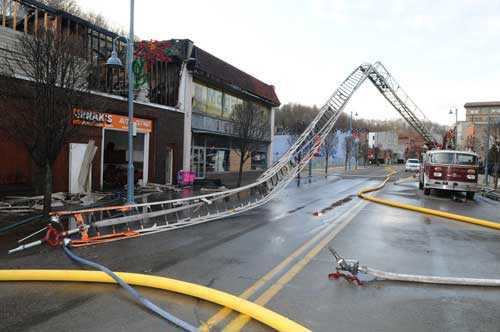
The collapsed aerial ladder
(Courtesy of Fire Department)
Contributing Factors
- Lack of fire department standard operating procedures for aerial apparatus
- Positioning of the aerial apparatus for fireground operations
- Limited performance capabilities of the aerial apparatus
- Overloaded aerial ladder
Key Recommendations
- Ensure that a standard operating procedure (SOP)addressing the safe operation, including placement of the aerial apparatus on the fireground, is developed and implemented
- Ensure that a structured training program for aerial apparatus operation is implemented that addresses the safe operation and fireground positioning of the apparatus
- Ensure that all safety indicators are monitored and followed while operating the aerial
- Ensure that the manufacturer's apparatus manuals are retained for reference
- Ensure that operators of aerial apparatus are familiar with the operating characteristics and performance capabilities and in particular, are aware of the potential danger of collapse while operating at low angles and long extensions, especially if the aerial was built prior to 1991 NFPA standards
- Ensure that aerial devices are inspected and load tested regularly by qualified testing companies in accordance with a preventative maintenance SOP.
- Consider placing apparatus built prior to 1991 into reserve status and replacing apparatus that approach 25 years old
- Ensure that fire fighters are empowered to report and stop unsafe practices or activities
Introduction
On January 8, 2012, a career captain was injured during the collapse of an aerial ladder. The Pennsylvania State Fire Commissioner contacted NIOSH the same day and reported the aerial ladder collapse. On January 10, 2012, a general engineer and the safety and occupational health manager from the National Institute for Occupational Safety and Health (NIOSH) Fire Fighter Fatality Investigation and Prevention Program traveled to Pennsylvania to investigate this incident. The NIOSH investigators met with the Fire Chief, Union representative, and several members of the fire department. The investigators visited the incident site and impound yard to evaluate the aerial ladder. On January 18, 2012, the NIOSH general engineer accompanied by a fire apparatus technical consultant, returned to the impound yard to further evaluate the aerial ladder, interview key fire fighters that were on scene, and meet with the Fire Chief.
Fire Department
This career fire department has a station with 9 uniformed members who serve a population of approximately 10,000 within an area of about 4.5 square miles.
The department responds to an average of 1200 calls per year. The calls are diverse with over 40% being non-EMS-related. The department is part of a county-wide agreement and has an automatic aid agreement with a neighboring township.
The department's first alarm area involves: 1 mall, 9 strip malls, 1 industrial park, 3 low income housing developments, a hospital, 7 schools, 2 colleges, 4 high rise apartment buildings, 1 communications switching station, a natural gas transmission line, and one bridge that spans the Ohio River that is part of a nuclear power plant evacuation route. Additionally, the potential fire load is exacerbated because more than 80% of the structures were built prior to 1959.
Equipment
The incident involved a 1975 custom fire apparatus with a 100-foot rear-mounted aerial ladder (see Photo 1). The aerial device was constructed of welded steel, assembled in four sections. The vehicle was stabilized by two sets of hydraulically controlled outriggers (see Photo 2). The aerial ladder movements of raise/lower, extend/retract and rotation were powered hydraulically and controlled from a pedestal located at the turntable (see Photo 3). The fire department did not have a manufacturer's operator manual for this apparatus for review during this investigation.
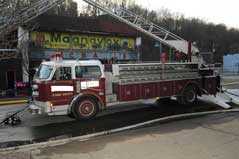
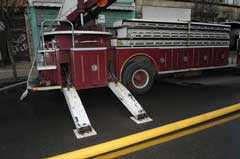
Photo 1. The Aerial Ladder Truck
(Courtesy of the Fire Department)
Photo 2. Shows the two sets of hydraulic outriggers.
(Courtesy of the Fire Department)
The rated aerial payload was unknown but the ladder had been inspected and tested in May of 2010 at the station with a 200 lb. test weight for the horizontal load test and 400 lb. test weight for the maximum elevation load test by a certified vendor. According to the certified vendor, the load test capacities were determined by the manufacturer's load chart or operator's manual. Note: Although the apparatus was overdue for its annual inspection, NIOSH does not believe this had an impact on the incident. The fire department had been awaiting delivery of a new aerial apparatus, but several delays from the manufacturer had postponed its arrival.
The control pedestal has an indicating device consisting of three windows displaying a message relative to the safe operation of the aerial device (see Photo 4). From left to right, the displays indicated conditions for: Top End Supported, Water Tower Operation and Top End Unsupported.
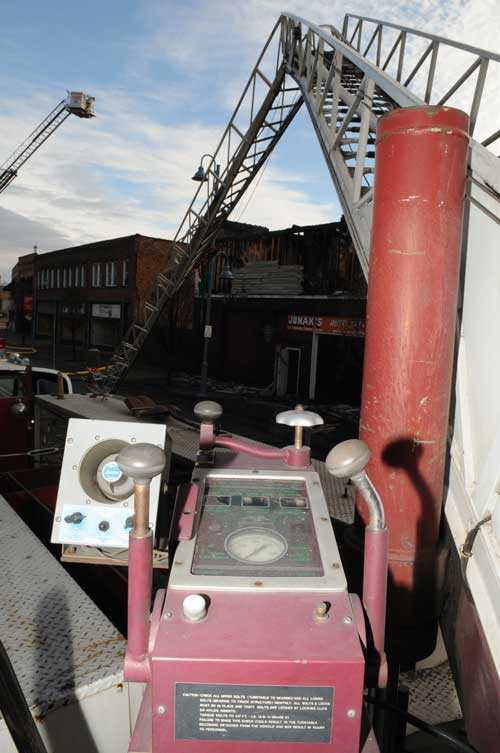
Photo 3. Aerial ladder control pedestal
(Courtesy of the Fire Department)
In addition, there was a safety warning plate on the side of the turntable which states: "There is no hard and fast rule to cover fully the use of ladders. The common sense, experience and judgment of the men handling them must be depended upon."

Photo 4. Three message windows displaying "Danger"
(Photo taken after collapse, courtesy of the Fire Department)
Personal Protective Equipment
At the time of the incident, the captain was wearing his turn out gear, boots, helmet, gloves and an SCBA with un-donned face piece.
Weather and Road Conditions
The weather was mostly cloudy with an approximate temperature of 31°F, relative humidity 79%, and a wind speed of 5.8 mph from the West.
Investigation
At approximately 0630 hours, an alarm came in for a structure fire in the downtown area. One pumper and one 1975 rear-mount, 100-foot aerial ladder responded to the call. Upon arrival, a working fire was confirmed in a 2 story frame auto repair/parts shop. The driver of the engine stopped at a hydrant on the side of the street nearest the fire building, wrapped a 5-inch large-diameter hose around the hydrant and proceeded to drive diagonally across the street to a location in front of the fire building. This laid the 5-inch supply hose from one side of the street to the other (see Diagram 1 and Photo 5). The ladder truck stopped at the hydrant and the driver was instructed to complete the connection and charge the line when the engine was ready to receive water. When signaled for water, the hydrant was opened and the engine captain began attacking the fire with a pre-connected master stream device from the street.
The driver of the ladder truck then pulled forward to get closer to the fire but stopped short, approximately 55 feet behind the engine to avoid running over the 5-inch LDH that was supplying water to the engine. Both apparatus were on the far side of the street, away from the collapse zone (see Diagram).
The driver of the ladder truck was then ordered to set-up the truck and prepare for ladder pipe operations. The outriggers were set and a portable ladder pipe was attached at the center of the tip on the fly section of the aerial ladder. Four (4) lengths of 3-inch hose were used to make the connection from the ladder pipe assembly, down the ladder, to the engine in front of the fire building. It is unknown if the hoseline was centered coming down the ladder. The aerial was raised to about 32 degrees, rotated to an approximately 1 o'clock position (the turntable was approximately 55½ feet north of the seat of the fire) and extended to near full extension (approximately 98 feet and approximately 45 feet off the ground at the tip) towards the fire building. In this configuration, the ladder pipe was positioned at a right angle to the ladder and the hose line was charged. The turntable operator attempted to apply water to the fire by rotating the turntable to direct the stream right and left. This operation went on for approximately ten minutes. Due to the positioning of the aerial apparatus in the street, the turntable operator was unable to hit the fire.
Seeing this, the captain left his position at the master stream and approached the turntable operator. He stated that the aerial stream was not hitting the fire and he was going to climb the ladder and manually operate the ladder pipe. The turntable operator assisted the captain in donning a safety belt. The operator applied the manual rung lock control and the aerial ladder was locked approximately in the position stated previously. The water flow to the master stream was stopped.
The captain began climbing the ladder and as he traversed the fly section the operator noticed that the tip was bouncing with each step he took. He also noticed that the ladder was twisting to the left. Note: During the interview process, a fire fighter stated that the aerial ladder had a natural twist to the left when near fully extended. When the captain reached the tip of the fly section, he got into a prone position to hook his safety belt on the ladder and begin operations. It was estimated that within a "few seconds" the ladder started to roll to the left and the captain moved to the right to hang on to the right rail of the ladder. It continued to twist to the left and the three ladder sections beyond the bed ladder began to slowly collapse. After collapsing approximately 10 feet it continued twisting to the left and descending. When the tip was approximately 15 feet above the ground, it began to pick up speed and struck the ground with the captain clinging to it. Note: The total approximate distance the captain fell while on the ladder was 45 feet. Several fire fighters rushed to assist the captain and the turntable operator went to the engine and shut down the ladder pipe hose line (see Diagram). The captain was transported to the hospital with non-life threatening injuries. Note: After the incident, the aerial ladder had to be cut off at the end of the bed section with a power saw so that the vehicle and aerial ladder could be transported to an impound yard.
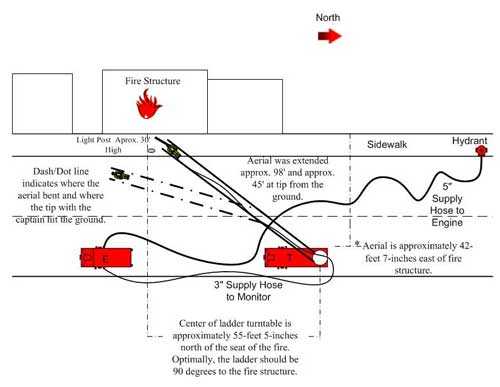 Diagram. Position of aerial at the time of the incident
Diagram. Position of aerial at the time of the incident
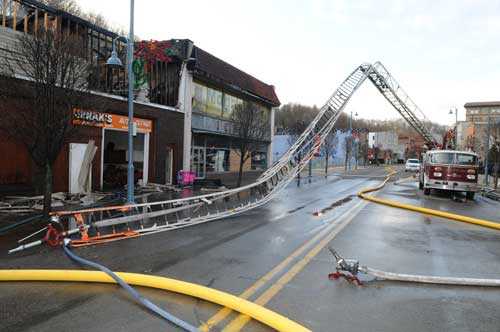 Photo 5. Note 5-inch supply hose laid from one side of the street to the other causing the driver of the aerial apparatus to stop short of fire structure.
Photo 5. Note 5-inch supply hose laid from one side of the street to the other causing the driver of the aerial apparatus to stop short of fire structure.
(NIOSH Photo)
Contributing Factors
Occupational injuries and fatalities are often the result of one or more contributing factors or key events in a larger sequence of events that ultimately result in the injury or fatality. NIOSH investigators identified the following items as key contributing factors in this incident.
- Lack of fire department standard operating procedures for aerial apparatus
- Positioning of the aerial apparatus for fireground operations
- Limited performance capabilities of the aerial apparatus
- Over loaded aerial ladder
Cause of Injury
According to the Fire Chief, the captain suffered multiple fractures to his left elbow from the aerial ladder failing and the approximate 45 feet drop to the asphalt roadway.
Recommendations
Recommendation #1: Fire departments should ensure that a standard operating procedure (SOP) addressing safe operation, including placement of the aerial apparatus on the fireground, is developed and implemented.
Discussion: The fire department had developed standard operating procedures that governed ladder company operations, but not safe and appropriate use of the apparatus. Written policies and SOPs enable individual fire department members an opportunity to read and maintain a level of assumed understanding of operational procedures. The NIOSH Alert, Preventing Injuries and Deaths of Fire Fighters, identifies the need to establish and follow fire fighting policies and procedures.1 To be effective, policies and procedures should be developed, fully implemented, enforced, and periodically revised. Being able to safely operate an aerial apparatus is paramount. Operators are tasked with having to maneuver the large apparatus through traffic, correctly position it at an incident for maximum use, avoid overhead hazards such as power lines and structures, and routinely work under stressful situations.2 A strong foundation established through SOPs and annual training will better adapt the aerial operator to make sound and safe decisions concerning the apparatus operation.
During the review process for equipment SOPs, the fire department should evaluate and address any safety measures to compensate for older equipment lacking modern safety features (i.e., audible tones and brighter lighting). These safety measures may require engineering modifications or controls (e.g. kill switches or hard stops) and/or the addition of personnel into the process, such as, a spotter.
In the incident, the fire department did not have an SOP or manufacturer's operating manual that described the safe operation of the aerial ladder, such as, safe limits on the elevation, extension, rotation, weight restrictions, and proper placement and use of the master stream.
Recommendation #2: Fire departments should ensure that a structured training program for aerial apparatus is implemented that addresses the safe operation and fireground positioning of the apparatus.
Discussion: The fire department had an SOP on apparatus response and placement within the city for structure fires which addressed placement of apparatus on the fireground in general terms. This SOP should be modified and trained on to include ladder deployment scenarios.
In this incident, the ladder was fully extended at a low incline which supports minimal weight at the tip. Note: The more vertical the ladder is the more weight can be supported by the load being transmitted down the beams of the ladder.3 It is estimated that the ladder was supporting 330 pounds (master stream approximately 30 pounds and water weight approximately 300 pounds from the 3-inch supply line) prior to the captain's ascent. The water weight is calculated at the center point of the ladder and distributed over the ladder's entire length. Therefore, each ladder section is carrying approximately half the load or 150 pounds. At this point, the ladder was at 75 % of the maximum weight tested at the tip at full extension and low incline angle. Adding a fire fighter with personal protective equipment (in this case, approximately 300 pounds) put the total weight at 192% of the safe load limit at the tip when applying a 250 pound minimum tip test weight.
As previously noted, a position nearer to the fire building may have allowed the aerial ladder to be deployed at less extension and steeper incline, enhancing the ladder's ability to support the weight of a fire fighter and water supply. Training all department members on the effects of fireground engine and truck placement could assist fire fighters in identifying operational situations within safe equipment operating parameters.
Recommendation #3: Fire departments should ensure that all safety indicators are monitored and followed while operating the aerial.
Discussion: The apparatus was equipped with a load indicating device for the aerial (see Photo #4). This device displayed warnings for three different load factors. This indicator was stated to have worked correctly prior to the incident. As part of an SOP, fire departments should ensure that loud indicators are checked before any personnel ascend the aerial ladder.
In this incident, the "Danger" warning was displayed in all three windows. These warnings were not observed by the captain or the fire fighter on the turntable.
Recommendation #4: Fire departments should ensure that the manufacturer's apparatus manuals are retained for reference.
Discussion: Although policies and procedures incorporate manufacturer's recommendations and guidelines, the apparatus operator's manual should be kept and made available for reference when questions arise. The operating manuals are important sources of information and should always be available to the operator of any fire apparatus.3 Additionally, manufacturer recommendations and guidelines from apparatus manuals support development of safe operating procedures and can be valuable resources for devising strategies and tactics for fire suppression operations.
All documentation and records should be maintained by the fire department for the life of the apparatus in accordance with NFPA 1911, Standard For The Inspection, Maintenance, Testing, And Retirement Of In-Service Automotive Fire Apparatus.4 Also, NFPA 1500, Standard on Fire Department Occupational Safety and Health Program, requires a preventive maintenance program be established and all records maintained.5
In this incident, the manual had been misplaced and was not available for reference regarding aerial specifications or performance capabilities that may have assisted the department in devising tactics to properly place the apparatus on the fireground in a location to deliver water on the seat of the fire without compromising its structural capacity.
Recommendation #5: Fire departments should ensure that operators of aerial apparatus are familiar with the operating characteristics and performance capabilities and in particular, are aware of the potential danger of collapse while operating at low angles and long extensions, especially if the aerial was built prior to 1991 NFPA standards.
Discussion: It was not until 1991 that the NFPA 1904, Standard for Aerial Ladder and Elevating Platform Fire Apparatus, specified minimum load requirements. Note: NFPA 1904 was a onetime standard. Now these requirements are in NFPA 1901, Standard for Automotive Fire Apparatus. Many aerial ladders prior to 1991 were not designed to support any load when extended at low elevation angles. The 1991 edition of the NFPA standard required an aerial ladder to be capable of operating in any position that the ladder will reach, while supporting a minimum tip load of 250 pounds. The design criteria also requires a minimum 2:1 safety factor for the strength of any structural component.6 Note: The rated aerial payload was unknown but the ladder had been inspected and tested in May of 2010 at the station with a 200 lb. test weight for the horizontal load test and 400 lb. test weight for the maximum elevation load test by a certified vendor. According to the certified vendor, the load test capacities were determined by the manufacturer's load chart or operator's manual.
The NFPA standards for fire apparatus are an evolving process and change on a cyclical basis, generally every 5 years. Fire departments need to be aware of these changes and how it applies to the apparatus they are operating. Additionally, these standard requirements are implemented can vary widely by each manufacturer. Even when apparatus are purchased from the same manufacturer the improvements incorporated by changes in standards, customer feedback, and manufacturer innovations can be significant.
Some of the ladders that were still in production when the standard changed had evolved from basic designs that originated prior to 1940. There are hundreds of these aerial ladders still in service and have proven to be reliable at relatively steep angles; however, they were not designed to be extended and operated at low elevation angles. They are also limited in their ability to resist lateral forces (see Photo 6).3
 Photo 6. Structural failure occurred at end of the ladder bed section.
Photo 6. Structural failure occurred at end of the ladder bed section.
(Courtesy of the Fire Department)
In this incident, the failure did not appear to have been caused by any defect or damage to the ladder.
Recommendation #6: Fire departments should ensure that aerial devices are inspected and load tested regularly by qualified testing companies in accordance with a preventative maintenance SOP.
Discussion: It is very important to regularly have aerial devices tested and certified to ensure that they are in proper operating condition and do not have any hidden damage or defects. 4 Developing policies and procedures on preventive maintenance can assist a fire department in performing scheduled maintenance, outsourcing work to be performed, monitoring maintenance conducted, and inspecting completed maintenance.4 Performing preventive maintenance on a vehicle can be time consuming and redundant at times, but the overall goal is to lengthen the life of a vehicle and diagnose potential problems before they pose a safety risk to the operator and/or passenger(s).5 Preventive maintenance can include things such as oil changes, lubrication, recording condition of parts, and replacing deteriorating parts. Additionally, preventive maintenance should be done only by appropriately trained and certified technicians. When outside vendors are utilized there should be contractual agreements in place with perspective vendors to ensure they have the appropriate qualifications and are familiar with the vehicle or apparatus to be maintained. These vendors should be qualified to perform work on fire apparatus and meet the recommended qualifications and certifications set forth in NFPA 1071 Standard for Emergency Vehicle Technician Professional Qualifications. 7
Fire departments need to be able to specify to the vendor what maintenance or work needs to be performed, question/research additional work suggested by the vendor, and verify, through visual inspection, that the work was performed to manufacturer and fire department specifications. The vendor should be provided with documentation as to what work should be performed and describe the events leading up to the vehicle issue. If the vendor finds something else wrong, a qualified fire department fleet representative should be able to research previous work performed on that vehicle to verify whether it had been done previously. This assists the fire department by allowing them to have the final say in whether or not a service is performed. Finally, qualified fire department personnel should visually inspect that the work requested to be performed was performed correctly with the appropriate equipment replaced to specifications. This provides for overall quality control of the work performed. If the fire department does not inspect and verify the work performed upon receipt of the vehicle from the vendor, then they risk a chance of potentially establishing responsibility and/or liability in the event that the vehicle component fails after it was purportedly inspected, serviced, and/or repaired by a vendor.8 This is especially important when multiple vendors could be used throughout the life of the vehicle.
In the incident, the apparatus had been inspected and tested in May 2010 but was overdue for its annual inspection. However, NIOSH does not believe this had an impact on the incident. The fire department had been awaiting delivery of a new aerial apparatus, but several delays from the manufacturer had postponed its arrival.
Recommendation #7: Fire departments should consider placing apparatus built prior to 1991 into reserve status and replacing apparatus that approach 25 years old.
Discussion: To maximize fire fighter safety, it is important that fire apparatus be equipped with safety features and operating capabilities. Significant improvements in safety features and capabilities of aerial fire apparatus have been made over the past 15 years. Fire departments should consider the value and risk to fire fighters in using apparatus over 25 years old per NFPA 1911. Fire departments should develop corrective measures to reduce the risk of an incident for apparatus over 25 years old.9 Apparatus manufactured prior to 1991 usually only included a few of the safety upgrades required by recent editions of the National Fire Protection Association (NFPA) fire department apparatus standards.10-13
Fire apparatus, like any other mechanical device, have a finite life. The life of the fire apparatus depends on many factors, e.g., vehicle use, quality of materials and workmanship by manufacturer, quality of maintenance, and replacement part availability.11
Fire departments that refurbish fire apparatus and place older components on a newer chassis and cab may still be lacking significant design and safety feature upgrades. Modern aerial platform fire apparatus designs locate the primary boom controls on the left or right side of the apparatus or on the turntable (the base of the boom or ladder which rotates with the boom or ladder). In addition, most modern apparatus have limit controls to prevent the aerial device from coming in contact with other parts of the cab and body.
Fire departments should consider upgrading older fire apparatus in accordance with NFPA 1912, Standard for Fire Apparatus Refurbishing (latest edition),12 and retire or replace older apparatus in accordance with current standards such as NFPA 1911, Standard For The Inspection, Maintenance, Testing, And Retirement Of In-Service Automotive Fire Apparatus (latest edition).4
Some departments may not have the resources or programs to replace or upgrade their apparatus and equipment as often as they should. Alternative funding sources, such as federal grants to purchase fire apparatus and equipment are available. The primary goal of the Assistance to Fire Fighters Grants (AFG) is to provide critically needed resources to help support equipment purchases such as emergency vehicles and apparatus, equipment, protective gear, training for responders and other needs to help fire departments protect the public and emergency workers from fire and related hazards. The Grant Programs Directorate of the Federal Emergency Management Agency administers the grants in cooperation with the United States Fire Administration.13
Additionally, there are government and non-governmental organizations that can assist fire departments in researching, requesting, and writing grant applications. Useful resources include:
- Federal Emergency Management Agency (FEMA), Assistance to Firefighters Grant Program 1-866-274-0960 or firegrants@dhs.gov. For more information from their web site go to http://www.fema.gov/welcome-assistance-firefighters-grant-program
- Federal Emergency Management Agency (FEMA), Fire Prevention and Safety Grants (FP&S) http://www.fema.gov/fire-prevention-safety-grants
- Federal Emergency Management Agency (FEMA), Staffing for Adequate fire and Emergency Response Grants (SAFER) http://www.fema.gov/staffing-adequate-fire-emergency-response-grants (Link updated 8/4/2009)
- National Volunteer Fire Council http://www.nvfc.org/hot-topics/grants-funding (Link updated 4/9/2013)
Recommendation #8: Fire departments should ensure that fire fighters are empowered to report and stop unsafe practices or activities.
Discussion: Although this recommendation may not have changed the outcome of this incident, fire departments should encourage all fire fighters to identify and stop potentially unsafe practices and situations which can help ensure the response progresses as safely as possible. The National Fallen Firefighters Foundation (NFFF) established the Everyone Goes Home® Program which developed 16 firefighter life safety initiatives. NFFF life safety initiative #4 states "All Firefighter's must be empowered to stop unsafe practices"14. Additionally, the International Association of Fire Chiefs (IAFC) developed "Rules of Engagement for Firefighter Survival" and "The Incident Commander's Rules of Engagement for Firefighter Safety" to provide guidance to individual firefighters and incident commanders, regarding risk and safety issues when operating on the fireground. The intent is to provide a set of "model procedures" for Rules of Engagement for Structural Firefighting to be made available by the IAFC to fire departments as a guide for their own standard operating procedure development. Item number 9 under the "Rules of Engagement for Firefighter Survival" states "You are required to report unsafe practices or conditions that can harm you. Stop, evaluate and decide." Item number 8 under the "The Incident Commander's Rules of Engagement for Firefighter Safety" states "Act upon reported unsafe practices and conditions that can harm firefighters. Stop, evaluate and decide." 15 Due to the many hazards fire fighters are exposed to, fire fighters should be encouraged to report and/or stop any unsafe practices or activities that may cause injury to any other fire fighter.
References
- NIOSH [1994]. NIOSH Alert: preventing injuries and deaths of fire fighters. Cincinnati, OH: U.S. Department of Health and Human Services, Centers for Disease Control and Prevention, National Institute for Occupational Safety and Health, DHHS (NIOSH) Publication No. 94-125 http://www.cdc.gov/niosh/docs/94-125/.
- NFPA [2009]. NFPA 1002 Standard for Fire Apparatus Driver/Operator Professional Qualifications, 2009 edition. Quincy, MA: National Fire Protection Association.
- FEMA[1996]. Aerial Ladder Collapse Incidents. U.S. Fire Administration/Technical Report Series, USFA-TR-081/April 1996
- NFPA [2012]. NFPA1911 Standard for the inspection, maintenance, testing, and retirement of in-service automotive fire apparatus 2012 edition. Annex D guidelines for first-line and reserve fire apparatus. Quincy, MA: National Fire Protection Association.
- NFPA [2007]. NFPA 1500 Standard on Fire Department Occupational Safety and Health Program, 2007 edition. Quincy, MA: National Fire Protection Association.
- NFPA [1991]. NFPA 1904 Standard for aerial ladder and elevating platform fire apparatus. Quincy, MA: National Fire Protection Association
- NFPA [2006]. NFPA 1071 Standard for emergency vehicle technician professional qualifications. 2006 ed. Quincy, MA: National Fire Protection Association.
- Mercury Associates [2009]. Report on maintenance practices assessment for the fire department. Gaithersburg, MD. Date accessed: August 2012.
- NFPA [2010]. NFPA 1250 Recommended Practice in Fire and Emergency Service Organizations Risk management, 2010 edition. Quincy, MA: National Fire Protection Association.
- NFPA [2007]. NFPA 1451 Standard for a fire service vehicle operations training program. 2007 ed. Quincy, MA: National Fire Protection Association.
- NFPA [2009]. NFPA 1901 Standard for automotive fire apparatus. Quincy, MA: National Fire Protection Association
- NFPA [2011]. NFPA 1912 Standard for fire apparatus refurbishing. Quincy, MA: National Fire Protection Association.
- Federal Emergency Management Agency, Grants Program, http://www.fema.gov/welcome-assistance-firefighters-grant-program. Date accessed: August 2012.
- NFFF [2006]. Firefighter Life Safety Initiatives. http://www.everyonegoeshome.com/16-initiatives/. Emmitsburg, Maryland. Date Accessed: August 2012. (Link Updated 5/13/2015)
- IAFC [2009]. Rules of engagement for structural firefighting, increasing firefighter survival. Draft manuscript developed by the Safety, Health and Survival Section, International Association of Fire Chiefs. Fairfax Va. March 2009. http://websites.firecompanies.com/iafcsafety/files/2013/10/Rules_of_Engagement_short_v10_2.12.pdf. (Link Updated 1/14/2014)
Investigator Information
This incident was investigated by Matt E. Bowyer, General Engineer, and Paul H. Moore, Safety and Occupational Health Manager, with the Fire Fighter Fatality Investigation and Prevention Program, Surveillance and Field Investigations Branch, Division of Safety Research, NIOSH located in Morgantown, WV and William Peters, of Peters Associates, Fire Apparatus Consulting Services, Inc. Mr. Peters is a retired Battalion Chief with over 28 years experience with the Jersey City, New Jersey Fire Department and is active in the National Fire Protection Association (NFPA) consensus standards process. This report was authored by Matt E. Bowyer and William Peters. An expert technical review was provided by Donald Frazeur, Assistant Chief, Los Angeles Fire Department. A technical review was also provided by the National Fire Protection Association, Public Fire Protection Division.
Additional Information Sources on Fireground Safety
IAFC Rules of Engagement for Firefighter Survival. The International Association of Fire Chiefs (IAFC) is committed to reducing firefighter fatalities and injuries. As part of that effort the nearly 1,000 member Safety, Health and Survival Section of the IAFC has developed "Rules of Engagement for Structural Firefighting" to provide guidance to individual firefighters, and incident commanders, regarding risk and safety issues when operating on the fireground. The intent is to provide a set of "model procedures" for Rules of Engagement for Structural Firefighting to be made available by the IAFC to fire departments as a guide for their own standard operating procedure development. http://websites.firecompanies.com/iafcsafety/files/2013/10/Rules_of_Engagement_short_v10_2.12.pdf. (Link Updated 1/14/2014)
Disclaimer
Mention of any company or product does not constitute endorsement by the National Institute for Occupational Safety and Health (NIOSH). In addition, citations to Web sites external to NIOSH do not constitute NIOSH endorsement of the sponsoring organizations or their programs or products. Furthermore, NIOSH is not responsible for the content of these Web sites.
The National Institute for Occupational Safety and Health (NIOSH), an institute within the Centers for Disease Control and Prevention (CDC), is the federal agency responsible for conducting research and making recommendations for the prevention of work-related injury and illness. In 1998, Congress appropriated funds to NIOSH to conduct a fire fighter initiative that resulted in the NIOSH "Fire Fighter Fatality Investigation and Prevention Program" which examines line-of-duty-deaths or on duty deaths of fire fighters to assist fire departments, fire fighters, the fire service and others to prevent similar fire fighter deaths in the future. The agency does not enforce compliance with State or Federal occupational safety and health standards and does not determine fault or assign blame. Participation of fire departments and individuals in NIOSH investigations is voluntary. Under its program, NIOSH investigators interview persons with knowledge of the incident who agree to be interviewed and review available records to develop a description of the conditions and circumstances leading to the death(s). Interviewees are not asked to sign sworn statements and interviews are not recorded. The agency's reports do not name the victim, the fire department or those interviewed. The NIOSH report's summary of the conditions and circumstances surrounding the fatality is intended to provide context to the agency's recommendations and is not intended to be definitive for purposes of determining any claim or benefit.
- Page last reviewed: November 18, 2015
- Page last updated: October 15, 2014
- Content source:
- National Institute for Occupational Safety and Health Division of Safety Research


 ShareCompartir
ShareCompartir